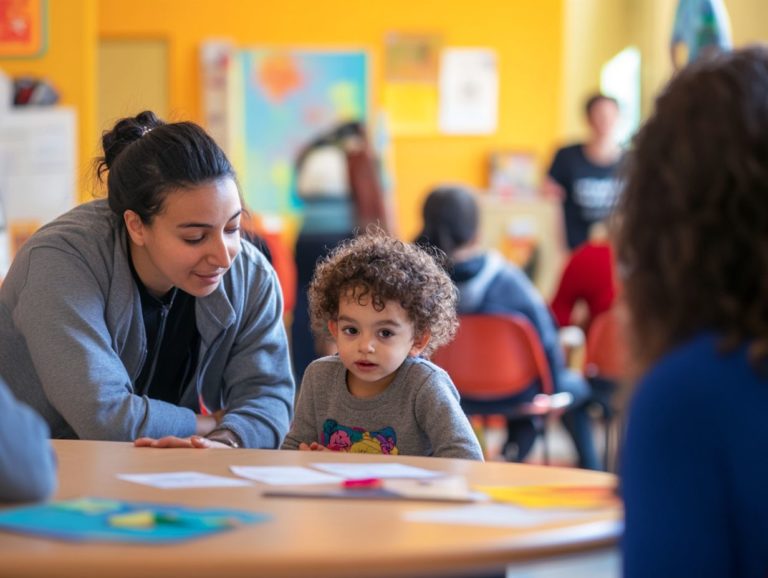maximize your language skills: immersion strategies
Language immersion presents an engaging and effective way to master a new language, allowing you to absorb and practice it in real-life contexts.
This article explores the many benefits of immersion, including enhanced fluency and retention, as well as a deeper cultural understanding. You’ll discover the different types of immersion full and partial and learn practical strategies for creating an immersive environment, whether through travel or within the comforts of your home.
As you go on this journey, we will also discuss common challenges, accompanied by valuable tips for overcoming them. Get ready to discover how immersion can truly transform your language learning experience.
Contents
- Key Takeaways:
- Benefits of Immersion for Language Learning
- Types of Language Immersion
- Strategies for Immersing Yourself in a Language
- Creating an Immersive Environment at Home
- Challenges and How to Overcome Them
- Dealing with Frustration and Homesickness
- Finding Support and Resources
- Frequently Asked Questions
- What are immersion strategies for maximizing language skills?
- How can immersion strategies help improve language skills?
- What are some examples of immersion strategies?
- Do immersion strategies work for all languages?
- Can I use immersion strategies without living in a target language country?
- How long does it take to see results from immersion strategies?
Key Takeaways:

- Immerse yourself in the language by traveling to a country where it is spoken or by creating an immersive environment at home.
- Full immersion provides the most effective results, but partial immersion can also improve fluency and cultural understanding.
- Overcome challenges in immersion, such as frustration and homesickness, by finding support and utilizing resources.
What is Language Immersion?
Language immersion is a powerful technique in your language learning journey, where you fully engage in a foreign language environment. By interacting with native speakers and immersing yourself in the language on multiple levels, you enhance your vocabulary and listening skills while gaining a richer understanding of the cultural context that surrounds the language.
Embracing this method allows you to develop a more intuitive grasp of grammar rules and the subtleties of conversation dynamics.
The concept of language immersion involves various components, including direct interactions with native speakers that foster real-time conversations and help you master authentic pronunciation. You may also find yourself participating in cultural activities, such as cooking classes or traditional celebrations, which serve to further contextualize your language studies.
Programs in countries like Ecuador and Peru exemplify this immersive experience, offering opportunities to live with host families. This arrangement not only improves your practical language skills in everyday settings but also speeds up your language acquisition while cultivating a deeper appreciation for local customs.
Ultimately, these experiences significantly enrich your overall learning strategies.
Benefits of Immersion for Language Learning
Immersing yourself in a foreign language offers profound benefits that elevate both your proficiency and confidence. By fully engaging with the language and understanding the role of travel in language learning immersion, you cultivate cognitive flexibility and hone essential skills in listening, reading, and writing.
This immersive experience not only enriches your understanding but also encourages you to embrace mistakes an essential component of effective learning.
Improved Fluency and Retention
One of the key benefits of language immersion is the remarkable improvement in fluency and vocabulary retention, which are essential for mastering a foreign language.
Immersive environments provide intensive listening practice while effectively using spaced repetition techniques, which means reviewing words and phrases at increasing intervals to help remember them better. This enables you to internalize grammar rules and expressions more naturally.
In these settings, you’ll often find yourself surrounded by native speakers, giving you the opportunity to engage in authentic conversations that deepen your understanding of colloquial expressions and cultural nuances.
Activities such as participating in local events, joining language exchange meetups, or utilizing language learning apps with speaking components all significantly contribute to your rapid progression.
Frequent exposure to the language through films, music, or interactive games can further reinforce what you ve learned, leading to improved retention and greater confidence in using the new language in various situations.
Cultural Understanding and Communication
Cultural understanding is vital for language immersion. It helps you communicate authentically with native speakers while learning vocabulary and grammar in context.
Participating in local festivals gives you a firsthand look at traditions and celebrations. You ll learn vocabulary related to these events and feel the meaning behind the words.
Using social media in your target language opens a window into informal conversations and local trends. Observing how native speakers interact online boosts your language skills and builds your cultural empathy.
Types of Language Immersion

Language immersion can be categorized into full immersion and partial immersion, each offering unique advantages for your language learning journey.
Full immersion places you completely in a foreign language environment. Contrast this with partial immersion, where you integrate the new language into your daily life.
Full Immersion vs. Partial Immersion
Both full and partial immersion have unique benefits for language acquisition. Programs like those at Middlebury Language Schools foster the ability to think in different ways and adapt rapidly to the new language.
In fully immersive environments, you re often required to communicate solely in the target language, significantly enhancing your skills.
Take Concordia Language Villages, where you live and breathe the language, engaging daily with native speakers and participating in cultural activities.
On the flip side, partial immersion, like bilingual education programs in various schools, allows for a gradual approach to language acquisition. This method builds your confidence while still drawing from your native language.
Strategies for Immersing Yourself in a Language
Employing top language learning strategies for success is crucial for crafting an immersive experience. Whether you’re at home or exploring abroad, utilize apps, participate in cultural activities, and prioritize listening practice.
Traveling to a Country Where the Language is Spoken
Traveling to a country where the language is spoken immerses you in real-life interactions. Countries like Ecuador and Peru are perfect for this, blending language practice with cultural experiences.
Engaging in local activities, such as cooking traditional dishes or attending lively festivals, enriches your experience and deepens your understanding of expressions and colloquialisms.
Visiting a community market lets you practice your skills while negotiating prices or discussing ingredients with local vendors. Joining cultural events like dance or music festivals creates an immersive environment that encourages language use in a fun and relaxed setting.
These experiences transform language learning into an enjoyable adventure, making it both memorable and impactful.
Ready to embark on your language adventure? Dive into the culture and language, and unlock a world of opportunities!
Creating an Immersive Environment at Home
Creating an immersive environment at home is a smart strategy for language learning. It allows you to engage with the language daily and practice listening skills comfortably. Using language apps, watching TV shows, and listening to podcasts in the target language can enhance your vocabulary and comprehension.
Incorporating these methods into your routine simulates real-life interactions and helps you understand cultural nuances. For instance, setting your phone or computer to the target language helps you get familiar with vocabulary in everyday contexts.
Join online language exchanges or conversation groups for invaluable speaking practice that enriches your experience. Don’t overlook the power of varied media sources, such as music or audiobooks, which can sharpen your listening skills.
This consistent exposure builds your listening confidence and deepens your understanding of cultural references, making the learning process both engaging and enjoyable.
Challenges and How to Overcome Them

While language immersion brings many benefits, it also presents challenges, including frustration and the fear of making mistakes. Acknowledging these obstacles is the first step to overcoming them. Actively seek support and use available resources to smooth your learning journey.
Dealing with Frustration and Homesickness
Frustration and homesickness often accompany language learning, especially during immersion experiences. However, you can manage these feelings with the right strategies and support systems.
Embrace mistakes as a natural part of the learning process. Connecting with local communities can significantly reduce feelings of isolation that come with learning in a new environment.
Participating in community events or language exchanges fosters friendships and provides practical contexts to apply your new skills. Online support groups can be a valuable lifeline where fellow learners share their experiences and encouragement.
This communal support can turn moments of frustration into powerful growth opportunities. Remember, everyone makes mistakes it’s essential for mastering a language and a stepping stone to fluency. Acceptance of these missteps builds resilience and enhances your language learning experience.
Finding Support and Resources
Finding the right support and resources can make your language journey exciting and effective! These tools and encouragement help you navigate the complexities of language learning.
Use language apps, engage with local communities, and access cultural resources to enhance your learning experience. Explore online platforms that connect you with native speakers through language exchange programs. These platforms often feature real-time conversations that boost your speaking skills.
Consider joining local classes or conversation clubs for structured environments where you can practice vocabulary and grammar in a supportive setting. Participating in cultural events, community gatherings, or workshops provides a rich context for understanding phrases that have unique meanings in specific languages.
By combining these diverse resources, you not only develop language proficiency but also foster deeper connections to the cultures associated with the languages you’re learning.
Frequently Asked Questions
What are immersion strategies for maximizing language skills?
Immersion strategies involve surrounding yourself with the target language and culture, actively engaging in activities that require you to use the language consistently. To make the most of this approach, consider these tips to enhance your language immersion experience.
How can immersion strategies help improve language skills?

Immersion strategies allow you to practice and reinforce your language skills in real-life situations, and using tips for immersing yourself in a new language can lead to faster and more natural language acquisition.
Start your language journey today and immerse yourself in new cultures!
What are some examples of immersion strategies?
Living in a country where people speak the language is one example of immersion.
You can also attend language exchange events or watch TV shows and movies in the target language.
Do immersion strategies work for all languages?
Yes, immersion strategies are effective for learning any language.
You need to be consistently exposed to the language and actively use it.
Can I use immersion strategies without living in a target language country?
Absolutely!
You can find language exchange partners, listen to podcasts or music in the target language, and use language learning apps in your daily routine.
How long does it take to see results from immersion strategies?
The time it takes to see results varies for each person.
However, if you use immersion strategies regularly, you can notice improvements in your language skills within a few months.






